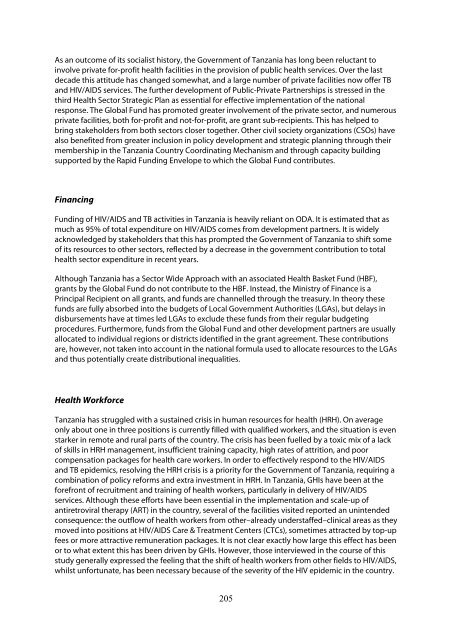MAXIMIZING POSITIVE SYNERGIES - World Health Organization
MAXIMIZING POSITIVE SYNERGIES - World Health Organization
MAXIMIZING POSITIVE SYNERGIES - World Health Organization
You also want an ePaper? Increase the reach of your titles
YUMPU automatically turns print PDFs into web optimized ePapers that Google loves.
As an outcome of its socialist history, the Government of Tanzania has long been reluctant to<br />
involve private for-profit health facilities in the provision of public health services. Over the last<br />
decade this attitude has changed somewhat, and a large number of private facilities now offer TB<br />
and HIV/AIDS services. The further development of Public-Private Partnerships is stressed in the<br />
third <strong>Health</strong> Sector Strategic Plan as essential for effective implementation of the national<br />
response. The Global Fund has promoted greater involvement of the private sector, and numerous<br />
private facilities, both for-profit and not-for-profit, are grant sub-recipients. This has helped to<br />
bring stakeholders from both sectors closer together. Other civil society organizations (CSOs) have<br />
also benefited from greater inclusion in policy development and strategic planning through their<br />
membership in the Tanzania Country Coordinating Mechanism and through capacity building<br />
supported by the Rapid Funding Envelope to which the Global Fund contributes.<br />
Financing<br />
Funding of HIV/AIDS and TB activities in Tanzania is heavily reliant on ODA. It is estimated that as<br />
much as 95% of total expenditure on HIV/AIDS comes from development partners. It is widely<br />
acknowledged by stakeholders that this has prompted the Government of Tanzania to shift some<br />
of its resources to other sectors, reflected by a decrease in the government contribution to total<br />
health sector expenditure in recent years.<br />
Although Tanzania has a Sector Wide Approach with an associated <strong>Health</strong> Basket Fund (HBF),<br />
grants by the Global Fund do not contribute to the HBF. Instead, the Ministry of Finance is a<br />
Principal Recipient on all grants, and funds are channelled through the treasury. In theory these<br />
funds are fully absorbed into the budgets of Local Government Authorities (LGAs), but delays in<br />
disbursements have at times led LGAs to exclude these funds from their regular budgeting<br />
procedures. Furthermore, funds from the Global Fund and other development partners are usually<br />
allocated to individual regions or districts identified in the grant agreement. These contributions<br />
are, however, not taken into account in the national formula used to allocate resources to the LGAs<br />
and thus potentially create distributional inequalities.<br />
<strong>Health</strong> Workforce<br />
Tanzania has struggled with a sustained crisis in human resources for health (HRH). On average<br />
only about one in three positions is currently filled with qualified workers, and the situation is even<br />
starker in remote and rural parts of the country. The crisis has been fuelled by a toxic mix of a lack<br />
of skills in HRH management, insufficient training capacity, high rates of attrition, and poor<br />
compensation packages for health care workers. In order to effectively respond to the HIV/AIDS<br />
and TB epidemics, resolving the HRH crisis is a priority for the Government of Tanzania, requiring a<br />
combination of policy reforms and extra investment in HRH. In Tanzania, GHIs have been at the<br />
forefront of recruitment and training of health workers, particularly in delivery of HIV/AIDS<br />
services. Although these efforts have been essential in the implementation and scale-up of<br />
antiretroviral therapy (ART) in the country, several of the facilities visited reported an unintended<br />
consequence: the outflow of health workers from other–already understaffed–clinical areas as they<br />
moved into positions at HIV/AIDS Care & Treatment Centers (CTCs), sometimes attracted by top-up<br />
fees or more attractive remuneration packages. It is not clear exactly how large this effect has been<br />
or to what extent this has been driven by GHIs. However, those interviewed in the course of this<br />
study generally expressed the feeling that the shift of health workers from other fields to HIV/AIDS,<br />
whilst unfortunate, has been necessary because of the severity of the HIV epidemic in the country.<br />
205

















